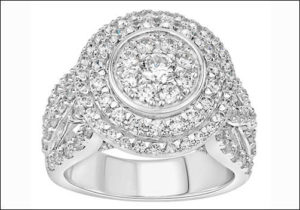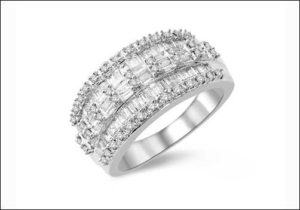Jewelry & Diamonds Still Shine
Demand for diamonds is at an all-time high!
Jewelry prevailed as the big winner for the holidays, even better than 2020 results, which were impressive enough, as we navigated COVID pre-vaccine.
Mastercard SpendingPulse found that during the 2021 holiday season, from Nov. 1 through Dec. 24, jewelry sales were up 32% year-over-year, and 26% year-over 2019. “Smaller boxes had a big impact,” the credit card company said in a press release. “Whether consumers were shopping for themselves or loved ones, the jewelry sector experienced some of the strongest year-over-year and year-over-two-year growth.”
Retail sales overall grew 8.5% year-over-year and 11% compared to 2019, with online sales up 11% over 2020, 61% compared to 2019. E-commerce made up 20.9% of total retail sales this holiday season, up from 20.6% in 2020, and 14.6% in 2019, according to Mastercard. The channel continues to experience elevated growth, as consumers enjoy the ease of browsing and buying from home.
“Shoppers were eager to secure their gifts ahead of the retail rush, with conversations surrounding supply chain and labor supply issues sending consumers online and to stores in droves,” Steve Sadove, senior advisor for Mastercard said in a press release.
Diamond Demand High
De Beers Group’s, in its 2021 Diamond Insight Report, tracked performance across the diamond industry for 2020 and the first half of 2021 and found that consumer demand for diamonds grew 40% year-on-year in the first half of 2021, or about 15% to 20% on an annualized basis compared with 2019.
As the final retail sales results become clear for 2021, diamonds are likely be the bestseller across all product categories in the U.S. market, from stud and hoop earrings to tennis bracelets, pendant necklaces, and eternity bands.
“This is a diamond year, both mined diamond and laboratory-grown diamond,” Stew Brandt, owner of H. Brandt Jewelers in Natick, Massachusetts, shared in December with the MetroWest Daily News. He told the newspaper that holiday business was brisk, with jewelry popular for Millennials, from custom engagement rings to classic diamond jewelry styles.
Demand for diamonds is at an all-time high! “Diamond jewelry sales increased at record levels in 2021, beating 2020 and 2019 by double digit gains,” reports Michael Lerche, president of Goldstar Jewellery, based in New York City. “All jewelry categories saw increases, particularly in bridal, anniversary and men’s jewelry. The 2022 forecast is still strong for jewelry sales as COVID continues to stay in the headlines.”
 Consumers have not been traveling much in the past two years and with the additional disposable income, jewelry is the most sought-after product, underscores Sagar Manilal, who manages sales for Indigo Jewelry in New York City. “Limited weddings and smaller gatherings happening in the past few years have allowed more income to be spent on the right ring.”
Consumers have not been traveling much in the past two years and with the additional disposable income, jewelry is the most sought-after product, underscores Sagar Manilal, who manages sales for Indigo Jewelry in New York City. “Limited weddings and smaller gatherings happening in the past few years have allowed more income to be spent on the right ring.”
Price Increases
The high demand for diamonds throughout last year, coupled with less diamonds being manufactured, is causing a rise in diamond prices that will affect retail in 2022, says Lerche. “Some areas of diamond supply are becoming harder to source, mostly in the lower, commercially priced goods.”
The increase in prices is driven by strong demand for jewelry in the U.S. and China, set against limited supply, as diamond mining and cutting remain low, reports recent market research by IndexBox.
“Natural diamond prices are increasing dramatically due to the high demand and limited supply that is due to the fixed number of manufacturers and cost of manufacturing. It is the same for natural and lab grown,” says Manilal.
In the first quarter of 2021, global production for rough diamonds fell by 22% to 24 million carats due to suspension at the Canadian Ekati diamond mine, the closure of Australia’s Argyle mine, and the decrease in activity at other large mining companies.
Rough diamond prices started rising in July, and then the outbreak of Omicron in diamond mining regions of South Africa and Botswana pushed up prices another 20%, reports Economic Times in December. Polished prices have gone up 10% to 15%, but a further increase is required to maintain profitability of the units.
With a spike in Covid-19 cases, India introduced quarantine restrictions, which led to a drop in factory utilization by 50% to 70%, an outflow of migrant workers, and a decrease in the volume of diamond cutting and polishing operations, reports IndexBox. The sharp increase in rough diamond prices inspired diamond exporters to decrease their rough purchases, thereby reducing the need for cutting and polishing, which adversely affected the diamond workers in Surat.
“The close of the Argyle mine, which predominantly supplied SI and lower quality diamonds, is causing prices to increase in lower quality diamonds,” says Manilal. “Cutting SI and lower quality diamonds have a higher risk of breakage than better quality diamonds, the manufacturer gets paid about the same irrespective of the diamond quality, so higher quality diamonds have been made due to limited manufacturing capabilities due to COVID restrictions.”
Manilal is seeing price increases up to 50%. “We’re seeing bigger price corrections in smaller goods, mostly SI quality and lower, with increased demand and limited supply. I think these prices are here to stay.”
Lenny Kramer for Leo Schachter Diamonds in New York City concurs that prices have gone up as evidenced by DeBeers’ and other producers’ price increases, market activity, as well as several recent Rapaport price increases in both rounds and fancies. “We’re at a critical crossroads where the products we used to price at X are now pricing X++. Will jewelers buy? Will consumers buy?” It remains to be seen if these increases are sustainable.
Inventory management, Manilal concurs, will be the biggest challenge this year. Most notably as 2022 is expected to be a banner year for weddings. The Wedding Report forecasts 2.5 million U.S. couples will tie the knot, surpassing the previous record set in 1984 of 2.49 million marriages.
Millennials, who are searching for something unique, and have not been raised necessarily on the round brilliant diamond ideal, are finding they can get a larger stone for the money than traditional round diamonds.
 “Fancy-shaped diamonds are taking a bigger piece of the sales pie,” says Manilal. “Fancy-shaped diamonds are less expensive because they use more of the original rough when manufactured, which allows for a larger stone to be cut than traditional round diamonds. Most poplar shapes have been elongated, like oval, pear and marquise.” He finds the availability of easy financing the key to closing sales at retail for higher-priced items.
“Fancy-shaped diamonds are taking a bigger piece of the sales pie,” says Manilal. “Fancy-shaped diamonds are less expensive because they use more of the original rough when manufactured, which allows for a larger stone to be cut than traditional round diamonds. Most poplar shapes have been elongated, like oval, pear and marquise.” He finds the availability of easy financing the key to closing sales at retail for higher-priced items.
The Plumb Club Insights 2021 report finds that more consumers (84% of the over 1,000 surveyed in the U.S. last year) prefer buying natural over lab-grown if given the opportunity.

